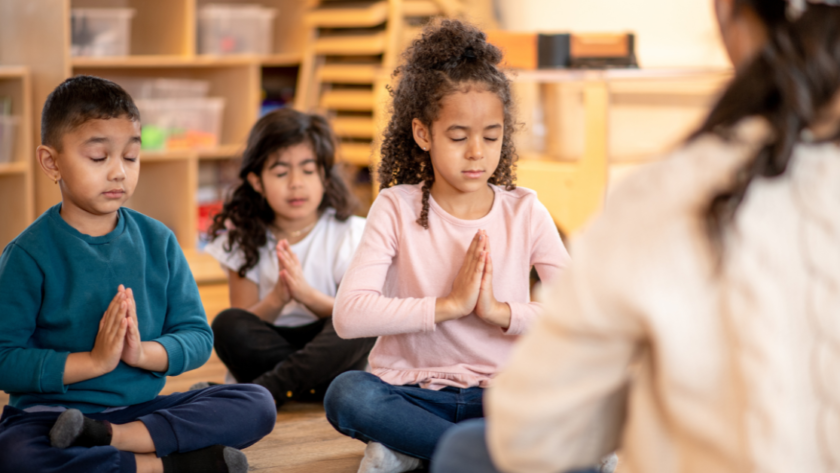When I first introduced guided meditation to my energetic group of third-graders, I was unsure what to expect. As a teacher and mindfulness enthusiast, I’d experienced the benefits of meditation firsthand, but I wondered if these techniques would work with children.
To my amazement, the results were remarkable.
Within weeks, I noticed a significant shift in the classroom atmosphere. Students who once struggled to sit still were now able to focus for longer periods.
Those prone to emotional outbursts found new ways to manage their feelings.
Even the most skeptical kids began to look forward to our daily ‘quiet time.’
This experience sparked my passion for exploring and sharing the power of guided meditation for children. Over the years, I’ve researched extensively, experimented with various techniques, and seen countless young minds flourish through mindfulness practice.
Understanding the Basics of Guided Meditation for Kids
Guided meditation for children helps young minds learn to be present, aware, and calm. Unlike adult meditation, which often involves extended periods of silence, kid-friendly meditation is typically more interactive, shorter in duration, and often incorporates storytelling or imaginative elements.
The theoretical foundation of this practice draws from both ancient wisdom traditions and modern neuroscience. Research has shown that regular meditation can change the structure and function of the brain, particularly in areas related to attention, emotional regulation, and self-awareness.
For children, whose brains are still developing, the potential benefits are especially significant.
Guided meditation can be applied in various settings – from classrooms and therapy sessions to bedtime routines at home. The key is to make it engaging and accessible for young minds.
One of the main challenges in introducing meditation to kids is overcoming their natural restlessness and short attention spans. This is where creativity comes into play.
By incorporating movement, visual aids, and age-appropriate themes, we can make meditation an enjoyable and rewarding experience for children.
A Step-by-Step Guide to Implementing Guided Meditation for Kids
1. Create the Right Environment
Start by setting up a calm, comfortable space. This could be a corner of the classroom with cushions or a quiet spot at home.
Dim the lights if possible and remove any potential distractions.
Consider using soft background music or nature sounds to create a soothing atmosphere.
2. Introduce the Concept
Explain meditation in simple terms that children can understand. I often describe it as ‘gym for our minds’ or ‘giving our brains a chance to rest and grow stronger.’ Use age-appropriate analogies and examples to help kids grasp the concept of mindfulness.
3. Start with Breathing
Begin with basic breathing exercises to help children focus their attention. A favorite of mine is the ‘balloon breath,’ where kids imagine inflating a balloon in their belly as they inhale and deflating it as they exhale.
Another effective technique is counting breaths, encouraging children to focus on the sensation of air moving in and out of their bodies.
4. Use Guided Imagery
Lead children through simple visualizations that engage their imagination. For example, invite them to imagine walking through a peaceful forest, floating on a calm lake, or lying on a warm, sunny beach.
Engage all their senses in the imagery by asking questions like, “What do you see? What sounds do you hear? How does the air feel on your skin?”
5. Incorporate Movement
For younger children especially, include gentle movements or stretches to help release excess energy and make it easier to settle into stillness. This could involve simple yoga poses, slow arm movements, or even a short ‘mindful walking’ exercise before sitting down to meditate.
6. Keep it Short
Start with just a few minutes of meditation and gradually increase the duration as children become more comfortable with the practice. For younger kids, 2-5 minutes might be enough, while older children may be able to focus for 5-10 minutes or more.
7. End with Reflection
After the meditation, encourage kids to share their experiences. This helps reinforce the practice and allows them to learn from each other.
Ask open-ended questions like, “How did your body feel during the meditation?” or “What did you notice about your thoughts?”
Common Pitfalls and How to Avoid Them
Expecting Adult-like Meditation
One of the biggest mistakes I see is adults expecting children to meditate like mini-adults. Remember, kids are naturally wiggly and easily distracted. Instead of fighting this, work with it.
Allow for some movement and don’t insist on perfect stillness or silence.
Embrace a more flexible approach that accommodates children’s natural tendencies.
Making Meditation Feel Like a Chore
Always present meditation as a positive, nurturing activity. If a child is resistant, don’t force it.
Instead, try different approaches or take a break and come back to it later.
Experiment with various techniques to find what resonates with each child. Some may prefer guided visualizations, while others might enjoy body scan meditations or mindful movement exercises.
Lack of Consistency
Inconsistency can undermine the benefits of meditation. Establish a regular practice, even if it’s just for a few minutes each day.
Consistency is crucial in helping children develop this skill.
Consider incorporating meditation into daily routines, such as at the start of the school day or before bedtime.
Neglecting to Model the Practice
Children learn by example, so it’s essential for adults to practice meditation themselves. When kids see their parents, teachers, or caregivers engaging in mindfulness, they’re more likely to view it as a valuable and normal part of life.
Adapting Meditation Techniques for Different Ages and Needs
Preschoolers and Early Elementary Students
For younger children, focus on simple breathing exercises and short, story-based meditations. Use lots of imagery and make it playful.
For example, you might guide them through a ‘butterfly meditation’ where they here’s a colorful butterfly landing gently on different parts of their body, bringing calm and relaxation.
Older Children and Teens
With older children and teens, you can introduce more abstract concepts and longer sessions. Explore different types of meditation, like loving-kindness or body scan techniques.
Encourage them to develop their own practice and find what works best for them.
You might also introduce mindfulness apps or guided meditations they can use independently.
Children with Special Needs
For children with special needs, such as ADHD or autism, you may need to change the approach. This might involve more frequent breaks, extra sensory elements, or one-on-one guidance.
For example, children with ADHD might benefit from shorter, more frequent meditation sessions throughout the day, while those with autism might respond well to visual aids or tactile objects to focus their attention.
Building on the Basics: Advanced Techniques
As children become more comfortable with basic meditation, you can introduce more advanced practices. This might include:
Mindful Movement Practices
Incorporate yoga or tai chi to mix physical activity with mindfulness. These practices can help children develop body awareness, improve balance and coordination, and learn to connect movement with breath.
Loving-kindness Meditations
Introduce meditations that cultivate empathy and compassion. Guide children to send kind thoughts to themselves, loved ones, and even people they find challenging.
This practice can help foster emotional intelligence and improve relationships.
Mindful Eating Exercises
Develop awareness around food and nutrition through mindful eating practices. Encourage children to eat slowly, savoring each bite and noticing the flavors, textures, and sensations of their food.
This can promote healthier eating habits and a greater appreciation for nourishment.
Gratitude Practices
Foster positivity and resilience through regular gratitude exercises. This could involve keeping a gratitude journal, sharing things they’re thankful for during family meals, or creating gratitude art projects.
Body Scan Meditations
Teach children to systematically focus their attention on different parts of their body, noticing sensations without judgment. This practice can help improve body awareness and reduce stress and tension.
Remember, the goal is not to create perfect meditators, but to give children tools they can use throughout their lives to manage stress, improve focus, and cultivate emotional well-being.
Exercises to Reinforce Learning
Mindful Walking
Take a short ‘awareness walk’ outdoors, encouraging children to notice sights, sounds, and sensations. Guide them to feel the ground beneath their feet, listen to the sounds around them, and observe the colors and shapes in their environment.
This practice helps children develop present-moment awareness and connect with nature.
Emotion Check-In
Use a ‘feelings thermometer’ or emotion cards to help kids identify and express their emotions before and after meditation. This exercise enhances emotional intelligence and self-awareness.
Encourage children to notice how their emotions might shift during and after meditation practice.
Mindful Listening
Play different sounds (nature sounds, music, etc.) and have children focus on listening without judgment. Ask them to notice the qualities of each sound – it’s pitch, volume, duration – and how it makes them feel.
This exercise sharpens auditory attention and teaches non-judgmental awareness.
Gratitude Journal
For older kids, introduce a simple gratitude journaling practice, writing down three things they’re thankful for each day. This can be done in the morning to set a positive tone for the day, or in the evening as a reflective practice.
Encourage them to be specific and to notice even small things they appreciate.
Mindful Art
Engage children in creative activities with a mindful twist. This could involve drawing or coloring mandalas, creating nature art, or painting while focusing on the sensations of the brush on paper.
These activities mix creativity with mindfulness, helping children express themselves while staying present.
Breath Awareness Games
Make breath awareness fun with games like ‘Breathing Buddies’ where children place a small stuffed animal on their belly and watch it rise and fall as they breathe. Or try ‘Hot Air Balloon,’ where they imagine their breath inflating a colorful hot air balloon that lifts them gently into the sky.
Mindful Sensory Exploration
Set up a ‘sensory station’ with various objects of different textures, shapes, and scents. Guide children to explore these objects mindfully, using all their senses.
This exercise heightens sensory awareness and encourages curiosity and present-moment focus.
The Science Behind Meditation for Kids
Recent scientific studies have shed light on the many benefits of meditation for children’s developing brains and overall well-being. Here’s a closer look at what researchers have discovered:
Brain Development
Neuroimaging studies have shown that regular meditation practice can lead to increased gray matter density in areas of the brain associated with learning, memory, and emotional regulation. For children, whose brains are still developing, this can have profound long-term effects on cognitive function and emotional well-being.
Attention and Focus
Research has demonstrated that mindfulness meditation can improve children’s ability to sustain attention and resist distractions. A study published in the Journal of Attention Disorders found that children who participated in an 8-week mindfulness program showed significant improvements in attention and executive function.
Emotional Regulation
Meditation has been shown to enhance emotional regulation skills in children. A study in the journal Frontiers in Psychology found that children who practiced mindfulness meditation showed improved ability to manage their emotions and decreased symptoms of anxiety and depression.
Stress Reduction
Regular meditation practice can help children develop resilience to stress. A study in the journal Pediatrics found that children who participated in a school-based mindfulness program showed lower levels of cortisol (a stress hormone) and reported feeling less stressed overall.
Social Skills
Meditation, particularly loving-kindness meditation, has been linked to improved social skills and empathy in children. A study in Developmental Psychology found that children who practiced loving-kindness meditation showed increased prosocial behaviors and improved peer relationships.
Academic Performance
Some studies have suggested that meditation can have a positive impact on academic performance. A review published in Educational Psychology Review found that mindfulness-based interventions in schools were associated with improvements in cognitive performance and psychological well-being.
These scientific findings underscore the value of introducing meditation to children and provide a strong rationale for incorporating mindfulness practices in educational settings and at home.
Integrating Meditation into Daily Life
While dedicated meditation sessions are valuable, the real power of mindfulness comes from integrating it into daily life. Here are some ways to help children bring mindfulness into their everyday experiences:
Morning Mindfulness
Start the day with a brief mindfulness practice. This could be as simple as taking three deep breaths together or sharing one thing you’re grateful for.
This sets a positive tone for the day and reminds children to carry mindfulness with them.
Mindful Transitions
Use short mindfulness exercises to help children transition between activities. For example, before starting homework, take a minute to do some calm breathing or a quick body scan.
This can help reset their focus and reduce stress.
Mindful Mealtimes
Encourage mindful eating by having children pause before meals to appreciate their food. Ask them to notice the colors, smells, and textures of their food.
This practice promotes mindfulness but can also foster healthier eating habits.
Bedtime Wind-Down
Incorporate a short meditation or relaxation exercise into the bedtime routine. This can help children calm their minds and bodies, preparing them for restful sleep.
A body scan or gentle breathing exercise can be particularly effective.
Mindful Technology Use
In our digital age, teaching children to use technology mindfully is crucial. Encourage them to take regular breaks from screens and to notice how they feel before, during, and after using devices.
This can help them develop a healthier relationship with technology.
Nature Connection
Encourage children to spend time in nature mindfully. This could involve taking a quiet walk in a park, cloud watching, or simply sitting outside and noticing the sounds of birds or the feel of the breeze.
Nature provides a wealth of opportunities for mindful awareness.
Emotional Check-Ins
Encourage regular emotional check-ins throughout the day. Ask children to pause and notice how they’re feeling.
This practice builds emotional intelligence and helps children become more aware of their inner experiences.
Mindful Communication
Teach children to practice mindful listening and speaking. Encourage them to give their full attention when others are talking and to think before they speak.
This can improve communication skills and relationships.
Gratitude Rituals
Incorporate gratitude into daily routines. This could be sharing something you’re thankful for at dinner time or keeping a family gratitude jar where everyone adds notes about things they appreciate.
Mindful Movement
Encourage mindful movement throughout the day. This could be stretching breaks during homework time, mindful walking between classes, or even mindful tooth brushing, focusing on the sensations and movements involved.
By weaving these mindful moments into everyday activities, we help children develop a habit of presence and awareness that can serve them well throughout their lives.
Addressing Common Concerns and Questions
As you introduce meditation to children, you might come across various concerns or questions from parents, teachers, or the children themselves. Here are some common issues and how to address them:
“My child can’t sit still. How can they meditate?”
Meditation for children doesn’t require perfect stillness. Many techniques incorporate movement or use the child’s natural energy.
Start with short, active meditations and gradually introduce quieter practices as the child becomes more comfortable.
“Isn’t meditation religious? We’re not comfortable with that.”
While meditation has roots in various spiritual traditions, the techniques taught in schools and most secular settings are non-religious. Focus on the practical benefits like improved focus, emotional regulation, and stress reduction.
“We don’t have time for another activity. How can we fit this in?”
Meditation doesn’t have to be time-consuming. Even a few minutes a day can be useful.
Encourage integrating short mindful moments into existing routines rather than seeing it as an additional task.
“My teenager thinks meditation is ‘uncool.’ How can I motivate them?”
For older children and teens, focus on the practical benefits that might appeal to them, such as improved sports performance, better test scores, or reduced anxiety. You might also introduce them to apps or online resources that make meditation more accessible and relatable.
“Will meditation make my child too passive or unambitious?”
On the contrary, meditation can help children become more focused and clear about their goals. It teaches them to respond thoughtfully rather than react impulsively, which can lead to better decision-making and achievement.
“My child has ADHD. Can they really benefit from meditation?”
Yes, studies have shown that mindfulness practices can be particularly useful for children with ADHD. However, the approach may need to be adapted, perhaps with shorter sessions or more movement-based practices.
“How do I know if my child is ‘doing it right’?”
There’s no ‘right’ way to meditate. Encourage children to approach it with curiosity rather than trying to achieve a particular state.
The key is regular practice, not perfection.
“What if meditation brings up difficult emotions for my child?”
It’s normal for meditation to sometimes bring awareness to challenging feelings. This can actually be useful, helping children learn to acknowledge and process their emotions.
However, if a child seems consistently distressed, it may be helpful to talk to a mental health professional.
By addressing these concerns openly and honestly, we can help create a supportive environment for children to explore and benefit from meditation practices.
Resources for Further Learning
As you continue your exploration of guided meditation for kids, here are some valuable resources to support your progress:
Books
- “Sitting Still Like a Frog: Mindfulness Exercises for Kids (and Their Parents)” by Eline Snel
- “Mindful Games: Sharing Mindfulness and Meditation with Children, Teens, and Families” by Susan Kaiser Greenland
- “A Still Quiet Place: A Mindfulness Program for Teaching Children and Adolescents to Ease Stress and Difficult Emotions” by Amy Saltzman
Apps
- Headspace for Kids: Offers guided meditations specifically designed for children of different age groups.
- Calm: Includes a section for kids with sleep stories and meditations.
- Smiling Mind: A free app with programs for different age groups, including children and teens.
Websites
- Mindful.org: Offers articles, guided meditations, and resources for teaching mindfulness to kids.
- GoNoodle: Provides movement and mindfulness videos for children.
- Cosmic Kids Yoga: Offers yoga, mindfulness, and relaxation designed specifically for kids.
Training Programs
- Mindful Schools: Offers online courses for educators interested in bringing mindfulness to their classrooms.
- MBSR-T (Mindfulness-Based Stress Reduction for Teens): A program specifically designed for teaching mindfulness to adolescents.
Audio Resources
- “Mindfulness Meditations for Kids” by Annaka Harris: A series of short, guided meditations for children.
- “Peace Out” podcast: Short stories that help children calm down and relax through visualization and breathing exercises.
Research Journals
- Mindfulness: A peer-reviewed journal that publishes papers on mindfulness and meditation, including studies on children and adolescents.
- Journal of Child and Family Studies: Often features research on mindfulness interventions for children and families.
These resources can provide deeper insights, practical tools, and ongoing support as you continue to explore and apply guided meditation for kids.
Key Takeaways
- Guided meditation can significantly improve children’s focus, emotional regulation, and overall well-being.
- Adapt meditation techniques to suit children’s ages, interests, and attention spans.
- Consistency is crucial – even short, regular sessions can have profound benefits.
- Make meditation fun and engaging, not a chore or punishment.
- As children progress, gradually introduce more advanced techniques to deepen their practice.
- Remember that every child is different – be patient and willing to experiment with various approaches.
- Integrate mindfulness into daily life to reinforce the benefits of formal meditation practice.
- Stay informed about the latest research and resources to continually enhance your approach to teaching meditation to kids.
People Also Asked
What age can kids start meditating?
Children can start learning simple mindfulness techniques as early as 3-4 years old. However, formal meditation practices are typically introduced around age 7-8 when children have developed more self-awareness and ability to focus.
How long should kids meditate for?
The duration depends on the child’s age and experience. Start with 1-2 minutes for younger children and gradually increase.
Older children might practice for 5-10 minutes or more.
Can meditation help with ADHD in children?
Yes, studies have shown that regular mindfulness practice can help improve attention, reduce hyperactivity, and enhance emotional regulation in children with ADHD.
Is guided meditation better than silent meditation for kids?
Guided meditation is often more effective for children, especially beginners. It provides structure and helps maintain focus.
As children become more experienced, they can gradually transition to silent meditation if desired.
How often should children meditate?
Daily practice is ideal, even if it’s just for a few minutes. Consistency is more important than duration when it comes to developing a meditation habit.
Can meditation help with childhood anxiety?
Yes, research has shown that mindfulness and meditation can be effective tools for managing anxiety in children. It helps them develop coping skills and emotional regulation.
What are some simple meditation techniques for kids?
Simple techniques include belly breathing, body scan, mindful listening, and guided imagery. These can be easily adapted for different age groups.
How can I motivate my child to meditate?
Make it fun and engaging. Use stories, games, and age-appropriate analogies.
Lead by example by practicing yourself, and praise their efforts rather than results.
Can meditation improve academic performance in children?
Some studies suggest that regular meditation practice can enhance focus, memory, and cognitive flexibility, which may contribute to improved academic performance.
Are there any risks associated with children meditating?
When taught appropriately, meditation is generally safe for children. However, it’s important to be aware that it may occasionally bring up difficult emotions.
If concerns arise, talk to a mental health professional.




